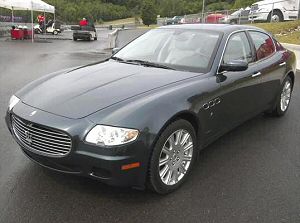I'd waited a long time to drive the new Quattroporte, or at least it seemed like a long time considering my self-proclaimed Maseratisti status. This, of course, makes me a little biased, a problem that most people would have for people or products that they have a certain affinity with.
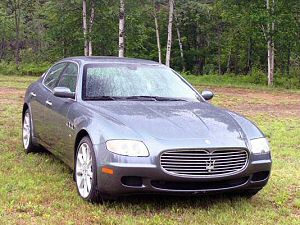 For me, it was a regular mid-'70s Saturday with my Dad, having gone downtown to do some inconsequential task we stopped off at the local exotic car emporium to ogle at the latest, greatest cars the world had to offer, or at least the best available in my neck of the woods. There were Jaguars and Porsches, a white Lotus Esprit Turbo on display and I seem to remember a brilliant blue Lamborghini Espada in the corner with a sold sign in the window. But the one that caught my eye was a metallic gray Maserati Mexico, with red leather hides and more wood paneling on the door, dash and centre console than I'd ever seen in the cabin of a car before. I sat inside while my father was caught up in some other interest, breathed in the smell of pigskin, wool carpeting, and high-test gasoline, a mixture modern cars sans carburetors can't emit, and fell in love. For me, it was a regular mid-'70s Saturday with my Dad, having gone downtown to do some inconsequential task we stopped off at the local exotic car emporium to ogle at the latest, greatest cars the world had to offer, or at least the best available in my neck of the woods. There were Jaguars and Porsches, a white Lotus Esprit Turbo on display and I seem to remember a brilliant blue Lamborghini Espada in the corner with a sold sign in the window. But the one that caught my eye was a metallic gray Maserati Mexico, with red leather hides and more wood paneling on the door, dash and centre console than I'd ever seen in the cabin of a car before. I sat inside while my father was caught up in some other interest, breathed in the smell of pigskin, wool carpeting, and high-test gasoline, a mixture modern cars sans carburetors can't emit, and fell in love.
I suppose that's why I just had to have a certain 1967 Maserati Mexico when it went up for auction some twenty years later. Me, fresh out of a marriage and desperately looking for every means of escapism life had to offer, successfully bid and acquired one of the rarest vehicles to ever grace this particular auctioneer's stand. Not only was it one of about 250 ever made, and that over an eight year model cycle, but my particular version featured the top-line 4.7-litre dual-overhead cam V8, a five-speed manual transmission and real pigskin hides - an expensive option in 1967.
Although I was leasing a relatively new vehicle already, the Mexico became my constant companion that summer. The sound of its refined V8, a unique combination nearly as bullish as a 427 Cobra yet almost as mechanically melodic as a V12 Ferrari, the Maser delivered phenomenal road manners for its era and the safety of four-wheel disc brakes and retro aircraft-style seatbelts. How could I leave it parked in the garage?
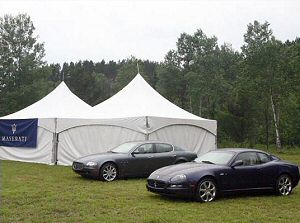 The rest of my Mexico story can be left for another time, as the new Quattroporte that I came to Mont-Tremblant, Quebec to test drive is now in front of me and my heart is doing the same pitter-pattering that had initially caused me to "invest" so much of my savings in my sweet '67. It's a strange phenomenon, this love for what for all rhyme or reason are merely inanimate objects. But maybe that's not entirely true. After all, since when did something inanimate move with such speed and grace? The rest of my Mexico story can be left for another time, as the new Quattroporte that I came to Mont-Tremblant, Quebec to test drive is now in front of me and my heart is doing the same pitter-pattering that had initially caused me to "invest" so much of my savings in my sweet '67. It's a strange phenomenon, this love for what for all rhyme or reason are merely inanimate objects. But maybe that's not entirely true. After all, since when did something inanimate move with such speed and grace?
Yes, the new Quattroporte is surprisingly deft of balance, considering its full-size dimensions and accompanying girth. It's so agile, in fact, and carries such amazing speed into sweeping corners, that it no doubt deserves one of the brand's trademark "wind" names rather than merely the Italian term for "four-door".
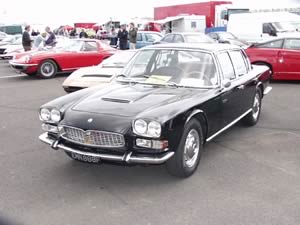 Similar to how Lamborghini has named its cars after prize fighting bulls, Maserati has chosen multilingual words for wind, such as Ghibli, Mistral, Bora, Merak, Khamsin, Kyalami and Shamal, plus the Buran and Kubang concepts, etc. But, unfortunately, like so many other brands, the Trident has succumbed to the alphanumeric naming game. To be fair though, its current 4200 GT Coupe and Spyder models were named after the lovely 3500 and 5000 GTs of the '60s, so there's some history there too. The same goes for the "four-door", a designation given to its 1964 Quattroporte when it debuted in the fall of 1963. That car was a forerunner to the modern day sport-luxury sedan, and despite being priced higher than many Ferrari's of the era, a fate that caused my Mexico to sell in such low annual volumes, Maserati's sedan did fairly well. Similar to how Lamborghini has named its cars after prize fighting bulls, Maserati has chosen multilingual words for wind, such as Ghibli, Mistral, Bora, Merak, Khamsin, Kyalami and Shamal, plus the Buran and Kubang concepts, etc. But, unfortunately, like so many other brands, the Trident has succumbed to the alphanumeric naming game. To be fair though, its current 4200 GT Coupe and Spyder models were named after the lovely 3500 and 5000 GTs of the '60s, so there's some history there too. The same goes for the "four-door", a designation given to its 1964 Quattroporte when it debuted in the fall of 1963. That car was a forerunner to the modern day sport-luxury sedan, and despite being priced higher than many Ferrari's of the era, a fate that caused my Mexico to sell in such low annual volumes, Maserati's sedan did fairly well.
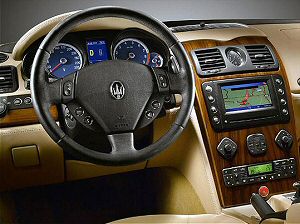 While the new Quattroporte might not be as revolutionary as the first iteration of the species, in the same way as there will never be another rock group with the impact of the Fab Four, it is nevertheless a unique and highly competitive model in its field. Unlike anything in its price class, from its lean, low and athletically inclined stance to its overwhelmingly luxurious yet technologically enticing cabin, Maserati's sedan imbibes a certain bespoke quality that can't be found in anything this side of a Bentley. While the new Quattroporte might not be as revolutionary as the first iteration of the species, in the same way as there will never be another rock group with the impact of the Fab Four, it is nevertheless a unique and highly competitive model in its field. Unlike anything in its price class, from its lean, low and athletically inclined stance to its overwhelmingly luxurious yet technologically enticing cabin, Maserati's sedan imbibes a certain bespoke quality that can't be found in anything this side of a Bentley.
What seems like a solid plank of highly polished walnut gently curves from the top of the dash down toward the front edge of the centre console, integrating Maserati's trademark analog clock plus a bevy of high quality HVAC and infotainment switches. An ergonomically designed steering wheel sits before a compact array of primary gauges, housed under an arcing shroud that effectively shields all surfaces from sunlight's glare.
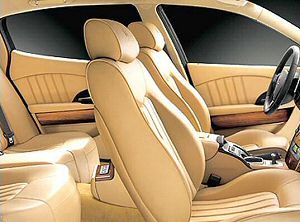 The seats, well they're an ideal blend of sumptuous comfort and driver-oriented support, bolstered amply for a day at the track, which was exactly why I had come all the way from the west coast to this particular location in la belle province, home of le Circuit Mont-Tremblant. It just so happens that the owner of this fabulous facility, which has hosted everything from Formula One and Can Am, in its past, to the American Le Mans Series since it was completely made over a number of years back, plus such renowned drivers as Andretti, Moss, Ickx, Rahal, Villeneuve, Tracy and Schumacher, the latter referring to it as "Little Nurburgring", also owns Montreal's Ferrari-Maserati dealership, and being part enthusiast, part businessman, it only made sense to open the track up for a little historic racing, a stopover for the Ferrari F360 Challenge series, plus a little fun in the sun with the 430, 612, and this lovely Quattroporte. The seats, well they're an ideal blend of sumptuous comfort and driver-oriented support, bolstered amply for a day at the track, which was exactly why I had come all the way from the west coast to this particular location in la belle province, home of le Circuit Mont-Tremblant. It just so happens that the owner of this fabulous facility, which has hosted everything from Formula One and Can Am, in its past, to the American Le Mans Series since it was completely made over a number of years back, plus such renowned drivers as Andretti, Moss, Ickx, Rahal, Villeneuve, Tracy and Schumacher, the latter referring to it as "Little Nurburgring", also owns Montreal's Ferrari-Maserati dealership, and being part enthusiast, part businessman, it only made sense to open the track up for a little historic racing, a stopover for the Ferrari F360 Challenge series, plus a little fun in the sun with the 430, 612, and this lovely Quattroporte.
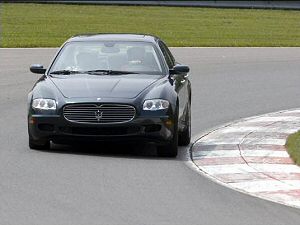 I've spent a fair number of days on the Tremblant circuit this year, driving Saleen Mustangs, Chrysler 300C SRT8s, Dodge Vipers, and the list goes on, plus in previous years have lapped a number of Porsches through its chicane, around its many right angle and hairpin curves and down its straights, but I have to say the opportunity to wring out a couple of Ferraris and a Maserati on what has become my favourite North American haunt is a rare occasion. I've spent a fair number of days on the Tremblant circuit this year, driving Saleen Mustangs, Chrysler 300C SRT8s, Dodge Vipers, and the list goes on, plus in previous years have lapped a number of Porsches through its chicane, around its many right angle and hairpin curves and down its straights, but I have to say the opportunity to wring out a couple of Ferraris and a Maserati on what has become my favourite North American haunt is a rare occasion.
The Ferrari-derived 4.2-litre V8 ignites with an immediacy that spoke volumes of its precise engineering, and the sweet purring from behind the firewall during idle is enough to stand the follicles on the backs of my hands on end. Like Ferrari's F1 transmission, the Quattroporte's sequential manual Cambiocorsa gearbox is actuated via large paddles directly behind the steering wheel, easily found by stretching the fingers forward and pushing or pulling to initiate up or downshifts respectively. Yes, that's a sequential manual transmission in a four-door sedan, the same system, albeit modified to be used within the Quattroporte's luxurious surroundings, as fitted to Ferrari's F430. Just for fun, name me another four-door with a paddle-shift actuated sequential manual gearbox? BMW M5? Yeah, the Quattroporte's in good company, no?
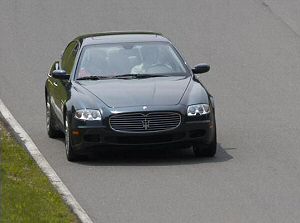 It's an intuitive system to operate, which makes getting through the pit lane and out onto the track almost like second nature. If you're not familiar with motorsport, pit lanes are to be respected, which means a car's speed needs to be kept reasonably low, making for a good opportunity to experience how Maserati's big sedan operates at low velocities. While not identical to winding through a busy city's maze of one-way streets in the early morning hours, the pit lane nevertheless makes it easy to feel how the Quattroporte would react during tight negotiations among the cars, trucks and minivans that make up a workday's traffic. It is light on its feet, changes lanes with an adept swiftness, and is wonderfully comfortable doing so. It's an intuitive system to operate, which makes getting through the pit lane and out onto the track almost like second nature. If you're not familiar with motorsport, pit lanes are to be respected, which means a car's speed needs to be kept reasonably low, making for a good opportunity to experience how Maserati's big sedan operates at low velocities. While not identical to winding through a busy city's maze of one-way streets in the early morning hours, the pit lane nevertheless makes it easy to feel how the Quattroporte would react during tight negotiations among the cars, trucks and minivans that make up a workday's traffic. It is light on its feet, changes lanes with an adept swiftness, and is wonderfully comfortable doing so.
But meandering through the pits isn't what I have come here to do, and the track that I've come to know so well is beckoning. Although the engine's displacement is only about two-thirds the size of the most recent V8-powered sedan I tested out on Tremblant, Chrysler's 6.1-litre 300C SRT8, it has no shortage of power. Acceleration out of the pits, on a track that immediately dives down a steep off-camber embankment with a right twist, before entering a sharp right corner that instantaneously curves to the left on a right angle, is effortless. Just to put things into perspective, the Quattroporte only needs 5.3 seconds to shoot from zero to 100 km/h, topping out at an impressive 275 km/h (177 mph). The engine spins freely too, stirring up an electrifying combination of mechanical sounds with a most satisfyingly robust bass note at the tailpipes. Again and again, quick flicks of the steering wheel mounted paddles select the exact gear needed, leaving the hands on the wheel where they're needed for optimum control.
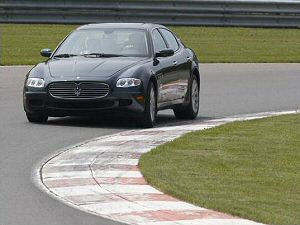 The Quattroporte's handling is good, very good. Actually, of the three cars I've tested today, this four-door is my second favourite through tight corners, feeling lighter on its feet than the ultra-expensive Ferrari 612 Scaglietti. Maybe I feel this way because I wasn't quite warmed up when I first went out in the 612, and if I could just spend more time in its driver's seat I'd understand its dynamics better and thus, find a way to make it take to the turns as easily as the Quattroporte, but no such time is available and I'm left with a rather surprising impression. The Quattroporte's handling is good, very good. Actually, of the three cars I've tested today, this four-door is my second favourite through tight corners, feeling lighter on its feet than the ultra-expensive Ferrari 612 Scaglietti. Maybe I feel this way because I wasn't quite warmed up when I first went out in the 612, and if I could just spend more time in its driver's seat I'd understand its dynamics better and thus, find a way to make it take to the turns as easily as the Quattroporte, but no such time is available and I'm left with a rather surprising impression.
No worries, I'm going to forget about the unreasonable and enjoy one of the best tracks in Canada in what I think might be one of the most engaging sport sedans ever built. Its agile suspension consists of a fully-independent double wishbone setup featuring Maserati's Skyhook continuously variable automatic damping system, an important element in counteracting the opposing lateral forces generated by the 1,929 kilo (4,253 lb) vehicle. Adding to the big sedan's tactility are 18-inch alloy wheels wrapped in 245/45ZR-18 front and 285/40ZR-18 rear Pirelli P Zero Rosso performance tires. The entire package is enhanced by the Italian marque's electronically controlled power steering system, MSP (Maserati Stability Program), allowing precise turn-in during high-speed activities without hampering low-speed maneuverability.
Did I mention that the engine likes to rev? Yes, that's true. And it sings such a sweet song in the upper realms of its limit that I just want to keep it pegged there, even if such is not the most efficient use of the 90-degree, 4.2-litre, V8 engine's abundant 400-horsepower and 333 lb-ft of torque - available at a lofty 7,000 rpm and 4,500 rpm respectively.
 And then it hits me. While trying my utmost to get the fastest lap time out of the Quattroporte as possible, I've only got a set number of laps before I have to come in and hand over the keys to some other lucky fool. Why don't I slow it down, recline the seat, stretch out and enjoy the ride? Why not stretch this experience out as long as possible...? Excuse me! As if? No. Momentary lapse of reason eliminated, and I've only lost a few milliseconds while maligned with such a silly thought. And then it hits me. While trying my utmost to get the fastest lap time out of the Quattroporte as possible, I've only got a set number of laps before I have to come in and hand over the keys to some other lucky fool. Why don't I slow it down, recline the seat, stretch out and enjoy the ride? Why not stretch this experience out as long as possible...? Excuse me! As if? No. Momentary lapse of reason eliminated, and I've only lost a few milliseconds while maligned with such a silly thought.
Down the back straight the Quattroporte remains completely stable, tracking superbly at much higher than legal speeds, at least in North America, and all the while its cabin is serenely quiet, except for the aforementioned engine and exhaust notes. The car is incredibly smooth too, although the glass-like tarmac that covers the Tremblant circuit is hardly a credible testing surface for gauging comfort levels.
Brakes? There's no a reason for concern here, which is ironic considering the majority of cars I've tested on this track have at the very least smoked a little from the front calipers. The Maserati's binders, however, continue to stop at near full capacity time and time again after being brutally punished before the tightest corners. I'm not saying that I'm riding the brakes all the way round the track, but rather that the speed the car is going combined with its rather hefty curb weight translates into an amazingly good braking system.
And as can be appreciated, such performance is typical of this car. Where most modern luxury sedans cosset their occupants in comfort while delivering decent driving dynamics, the Quattroporte follows a Maserati tradition of hedonistic opulence and supercar performance.
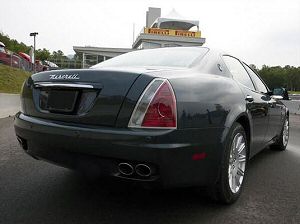 After nowhere nearly enough laps to satisfy my unquenchable thirst for track time, I pull into the pit entrance and coast down the lane towards a lineup of eager journalists. I know, it will probably be a long time before I get behind the wheel of this car again and therefore attempt to soak in as many of its auditory sensations, olfactory arousing aromas, tactile titillations and its visual feast of handcrafted technology. After nowhere nearly enough laps to satisfy my unquenchable thirst for track time, I pull into the pit entrance and coast down the lane towards a lineup of eager journalists. I know, it will probably be a long time before I get behind the wheel of this car again and therefore attempt to soak in as many of its auditory sensations, olfactory arousing aromas, tactile titillations and its visual feast of handcrafted technology.
The Quattroporte offers a balance of sport and luxury unmatched in the full-size premium sedan segment, except possibly by Bentley's new Flying Spur. Of course, tack on another $80,000 plus for the VW-owned super sedan, a thought which makes the Maser even more enticing.
Its "reasonable" $143,280 window sticker is less than you'll need to put out for a 12-cylinder powered Audi, BMW or Mercedes-Benz, and Maserati's cachet is much more appealing, as far as name dropping goes. Even if the person on the other end of the conversation doesn't know what a Maserati is, the name alone sounds fast, exotic, expensive and exclusive. Of course, it is all of these things, and does a suitable job of living up to the legendary Italian nameplate.
Specifications:
Price (base MSRP): $143,280
Body Types: 4-door sedan
Layout: front-engine, RWD
Base Engine: 400-hp, 333 lb-ft of torque, 4.2L, 32-valve, DOHC V8
Transmission: 6-spd paddle-shift actuated sequential manual)
Brakes (front/rear): disc/disc, ABS, EBD, MSR
Acceleration (0 - 100 km/h): 5.3 seconds
Top Speed: 275 km/h (177 mph)
Seating Capacity: 5
Fuel Economy (estimated city/hwy): 19.6 / 15.6 L/100 km
Safety: front and side airbags
Direct Competitors: Audi A8 W12; Bentley Continental Flying Spur; BMW 760Li; Jaguar XJR; Mercedes-Benz AMG S55, S600, AMG S65; Volkswagen Phaeton W12
Web Site: Official Maserati Website
Web Site: Canadian Auto Press |
